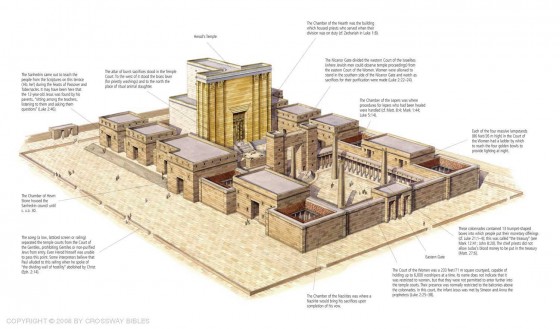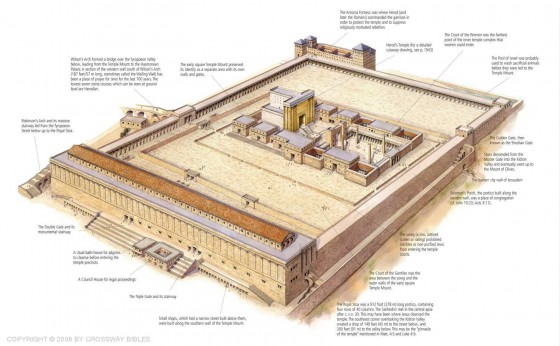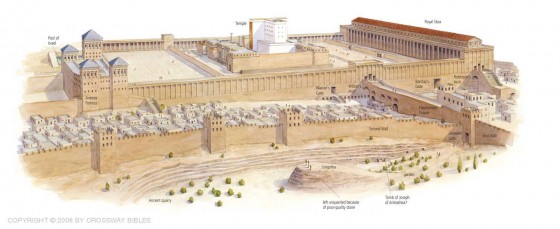Have you ever wondered what it would have been like to step inside Herod’s Temple in Jerusalem? It may surprise you to learn that Jesus himself never had this experience, since he never entered the Temple itself.
Only selected priests were allowed into the Temple sanctuary. And only the High Priest, once a year on the Day of Atonement, could go into the Holy of Holies in the back of the Temple.
In fact, there’s only one scene in the entire New Testament that takes place inside the Temple itself. The priest Zechariah was chosen by lot to enter the Temple and to burn incense at the golden altar (Luke 1:9).
Looking Inside the Temple
Imagine the scene: a dark cold room with a 60-foot-high ceiling: the elderly man’s shaking as he begins to burn the incense—perhaps a once-in-a-lifetime opportunity—standing before the thick, enormous curtain that separated this room from the Holy of Holies.
Taken from the ESV Study Bible and the Crossway ESV Atlas, here’s the best current scholarly understanding of what the Temple would have looked like:

If you look closely at the picture you may be able to see a priest inside the Temple wearing the sort of garments Zechariah might have worn. Luke 1:11 then tells us that an angel appeared to the right of the altar, announcing to the elderly man that his barren wife, Elizabeth, would bear a son (whom we know as John the Baptist). As we read the story and recreate the scene, we are witnessing an announcement about the Announcer — a proclamation about John the Baptist who would proclaim the arrival of the Messiah—Jesus of Nazareth.
Walking around the Temple Courts
The first time we hear of Jesus at the Temple, he is almost seven weeks old, and Mary and Joseph bring him to the Temple courts to “present him to the Lord” (Luke 2:22).
If you look at the picture below, you’ll see the Court of Women (the open square with four lampstands in each corner):

It was a square courtyard, 233 feet on each side (for comparison, a football field is 360 feet long). Within it stood four massive lampstands, each 86 feet tall.
It’s not that this was a place only for women, but it was the farthest point that women could go toward the Temple. This is the place where the 84-year-old prophetess Anna worshiped “with fasting and prayer night and day,” and who became a grateful evangelist when she saw Mary and Joseph with baby Jesus at his dedication (Luke 2:36–38).
This is the same place 30 years later when Jesus would observe the religious rich making their offerings and the poor widow making hers. Within the colonnades surrounding the court there were 13 wooden boxes for collecting money. Coins would be dropped through a bronze trumpet-shaped receptacle — and you could tell the size of the coin by listening to the sound that it made when the money was deposited. The rich, Jesus observed, “contributed out of their abundance,” while the poor widow gave more—contributing just a fraction of a penny—”all she had to live on” (Luke 21:4). A few years later, after Judas had betrayed Jesus, the chief priests decided that they couldn’t deposit the 30 pieces of silver into this treasury because it was “blood money” (Matt. 27:6).
But we’re getting ahead of ourselves.
Beholding the Real Temple
After Jesus contrasts the offering of the poor widow and the religious rich, people started “speaking of the temple, how it was adorned with noble stones and offerings” (Luke 21:5). One of Jesus’ disciples got so excited he tried to get Jesus to join in: “Look, Teacher, what wonderful stones and what wonderful buildings!” (Mark 13:1).
Now to get a sense of how massive this was, take a look at the illustration below, showing the entire Temple Mount. According to many scholars, the corner closest to you is the “pinnacle of the Temple” where Satan tempted Jesus—a frighteningly high point that created a 450-foot drop down to the valley below (essentially equivalent to standing on top of a 45-story building and being dared to jump). It was probably near this place—in front of the Royal Stoa—that Jesus cleansed the Temple from moneychangers who were turning a place of prayer into a den of thieves.

The ESV Study Bible also provides you with a different angle of the Temple Mount. In the picture below, the perspective is rotated so that you can see the back of it (viewed from the northwest).

I know it’s difficult in a picture like this to get a sense for the size—but to put things in perspective, the long Western Wall of the Temple Mount was 1590 feet long (the length of about 4.5 football fields). In the center of the Mount you can see the white back of the Temple—which we saw above. It stood about 10 to 16 stories tall. It’s no wonder that the disciples and everyone else got so excited about the beauty and grandeur of this construction.
But the look a bit closer at the image. Drop your eyes to the bottom of the image.
Outside the city walls you’ll find a simple, unattractive hill. Not far from it were tombs cut into the rock, housing the shrouded but decaying bodies of those who had died.
The hill is Calvary.
This is where our Savior—the Creator of the universe, the hope of the world—was mocked, tortured, and killed.
As Jesus hung from the cross, he could have turned his thorn-crowned head to the left and seen one of the thieves being crucified with him. Behind the thief, in the distance, he would have seen the shining temple—which the disciples had stared at in wonder. They couldn’t peel their eyes from the physical temple, wanting Jesus to join in their excitement about shadows and copies—not fully aware that they were actually standing next to the True Temple—God Incarnate, in whom “all the fullness of God was pleased to dwell” (Col. 1:19).
Inside the back wall of the Temple was the Holy of Holies. Look again inside the Temple (the first picture above), and you’ll again see the massive curtain that blocked this Most Holy Place, forbidding access to it. But when Jesus died, that “curtain of the temple was torn in two, from top to bottom” (Matt. 27:51). It was a picture of what Jesus had just accomplished.
In the most painful death ever experienced, we are now able “to enter the holy places by the blood of Jesus, by the new and living way that he opened for us through the curtain, that is, through his flesh” (Heb. 10:20).
Praise be to God.
Jesus was dead, but now he lives. He descended to earth, but has now ascended back to the Father. He was mocked and tortured, but now he is ruling and reigning.
- O death, where is your victory?
O death, where is your sting?
“Destroy this temple, and in three days I will raise it up” (John 2:19). They destroyed it; he raised it.
Christ—the True Temple of God—is Risen. He is Risen indeed.
![]()
*All the images in this article are copyright Crossway Bibles, and should not be posted elsewhere without permission from Crossway. An earlier version of this article was published on Boundless.org on October 7, 2008. To view these images in print, see the ESV Study Bible and the Crossway ESV Atlas.


















